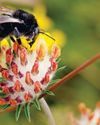
THERE cannot be many gardens without one or two hardy geraniums or cranesbills, so-called because of their long, beak-like seed capsules. The genus consists of 300 species from temperate regions of the world and we have a few garden-worthy species growing wild in the UK, including the magenta-flowered bloody cranesbill (G.sanguineum), favouring mainly limestone areas, and the ethereal wood cranesbill (G. sylvaticum) whose loose, upright habit suits the wilder parts of a garden.
Well-established clumps tend to be long-lived, and if you take on a mature garden you might find Geranium x johnsonii ‘Johnson’s Blue’ (a hybrid between meadow cranesbill and G.himalayense) or mats of French cranesbill G. endressii topped by tiny pink flowers. These stalwarts are still worthy, but are now rivalled by a wide choice of plants including sterile hybrids which, unable to set seed, tend to produce larger, longer-lasting flowers over many months. Yet the likes of ‘Rozanne’ and ‘Patricia’ are still popular with bees and other pollinating insects.
When choosing a new cranesbill, we are usually keen for it to perform a particular role. This could be colonising a difficult dry, shady area (I’d go for mourning widow G. phaeum var. phaeum ‘Samobor’ or perhaps the ravishing dusky lilac-flowered G. x monacense ‘Claudine Dupont’).
Container living
This story is from the May 15, 2021 edition of Amateur Gardening.
Start your 7-day Magzter GOLD free trial to access thousands of curated premium stories, and 8,500+ magazines and newspapers.
Already a subscriber ? Sign In
This story is from the May 15, 2021 edition of Amateur Gardening.
Start your 7-day Magzter GOLD free trial to access thousands of curated premium stories, and 8,500+ magazines and newspapers.
Already a subscriber? Sign In

To dig or not to dig?
Should we be carrying out a full dig on plots now? Bob considers the pros and cons of the 'autumn dig' debate

The box ball blues
As if his beleaguered box hadn't already taken a beating, Toby now has to deal with some hungry box caterpillars

Save your own seeds
Masterclass on: seed saving

Strange sightings
Three unusual insects turn up in Val's garden in one day

A bolt from the blue!
Cornflowers are perfect for garden and vase

Winter moth prevention
Ruth shows you how to avoid maggoty tree fruits

Create a winter container
There are as many options as in summer

Lightweight gardening tools
AS well as being good for our mental health, gardening is also great exercise.

Autumn price round-up
AG finds better bargains in lesser-known brands

Rudbeckias
Rudbeckias are ideal for sunny summer patios and borders, with some able to survive our coldest winters